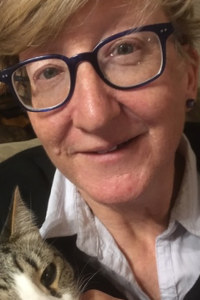Helicobacter pylori chemotaxis in the stomach: signaling diversity and niche colonization

Dr. Karen Ottemann
October 18 at 12:20pm in the Fralin Auditorium, 102 Fralin Hall
Hosted by Dr. B. Scharf
Dr. Ottemann earned a B.S. from UC Davis in Bacteriology and a Ph.D. in Microbiology and Molecular Genetics from Harvard University, where she studied Vibrio cholerae transcriptional regulation and pathogenesis with John Mekalanos. For her postdoctoral fellowship, she focused on E. coli and Salmonella chemoreceptor signaling with Daniel E. Koshland, Jr. at UC Berkeley. She is currently a Professor in the Department of Microbiology and Environmental Toxicology at UC Santa Cruz, where she has been since 1999. Dr. Ottemann’s laboratory focuses Helicobacter pylori pathogenesis, bacterial chemotaxis, and the role of bacterial chemotaxis in mammalian colonization.
Chemotactic motility is important for Helicobacter pylori to persistently colonize the stomach. Like other bacteria, H. pylori uses chemoreceptors and conserved chemotaxis machinery to modulate flagellar rotational direction and allow bacteria to move toward beneficial compounds and away from harmful ones. Our lab has been working to identify the roles that flagella, chemotaxis and chemoreceptors play during the challenges H. pylori faces during life in the stomach. We found that H. pylori uses flagella both for motility and for adherence to cells and surfaces. Indeed, flagella seem to form a matrix-like material that promotes H. pylori-cell interactions. H. pylori expresses four chemoreceptors, which we’ve found each affect gastric colonization in distinct ways. Analyzing gastric colonization using detailed niche analysis in mouse models via a technique called bacterial localization in glands (BLIG) analysis, we have found that each chemoreceptors helps to control bacterial gland numbers at distinct times and places. Bacterial gland numbers positively correlate with inflammation, therefore, one function of chemotactic motility is to allow the bacteria to fine tune their numbers within an environment to prevent excess inflammation.
Collins, K. D., Hu, S., Grasberger, H., Kao, J. Y. & Ottemann, K. M. (2018). Chemotaxis allows bacteria to overcome host-generated reactive oxygen species that constrain gland colonization. Infect Immun 86, e00878–17–12 (N. E. Freitag, Ed.). American Society for Microbiology Journals.
Hathroubi, S., Zerebinski, J. & Ottemann, K. M. (2018). Helicobacter pylori Biofilm Involves a Multigene Stress-Biased Response, Including a Structural Role for Flagella. mBio 9, 385 (N. E. Freitag, Ed.).
Keilberg, D., Zavros, Y., Shepherd, B., Salama, N. R. & Ottemann, K. M. (2016). Spatial and Temporal Shifts in Bacterial Biogeography and Gland Occupation during the Development of a Chronic Infection. mBio 7, e01705–16. American Society for Microbiology.

This seminar will be livestreamed on the Fralin YouTube channel, but will not be recorded.




